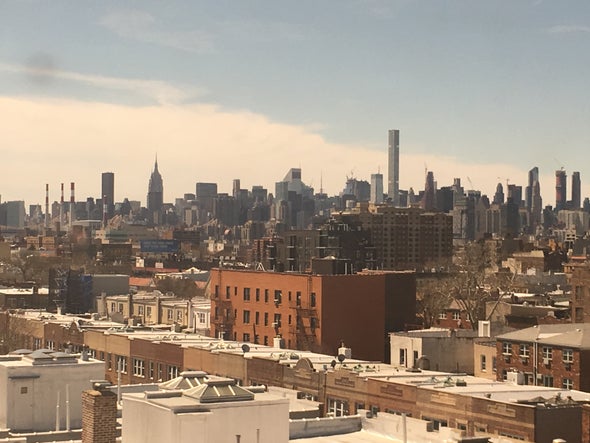(单词翻译:单击)
听力文本
This is Scientific American's 60-second Science, I'm Christopher Intagliata.
Restaurants, schools, dentist offices are all keeping more windows open to increase ventilation—and, hopefully, to decrease the chances of encountering the coronavirus. But letting in fresh air also lets in more noise.
Now researchers have come up with a device that's like noise-cancelling headphones—but for a building.
"It works on the same principle, so it detects noise that's coming into the windows and then is cancelling the noise."
Bhan Lam, an acoustical engineer at Nanyang Technological University in Singapore.
The device looks like a grid of small speakers and fits over an open window. A microphone samples incoming noise, then sends the speaker grid instructions on what sort of "antinoise" to emit. The result is to cancel out the incoming sound.
For example, here's the sound of a commuter train in Singapore with no noise control.
(CLIP: Before control)
Now here's that same sound with the array of noise-cancelling speakers turned on.
(CLIP: After control)
Compare that to a closed window.
(CLIP: Window closed SFX)

The antinoise device is almost as good and allows air to keep flowing into and out of the window. The details are in the journal Scientific Reports.
The device is just a prototype—so it's still expensive. And it doesn't block out all sounds. It only masks sound at frequencies from 300 to 1000 Hz—which includes the rumble of freeways, trains and planes. But even that could come in handy in a place like Singapore.
"Gimme a second, there's a plane flying past."
Bhan says Singapore already has a lot of green buildings that use natural ventilation.
"But the downside is: when you have lots of openings in the buildings, the noise comes in, so you need some way to manage the increasing noise."
A grid of window speakers could do the trick—especially if people prioritize peace and quiet over a good view, which folks at home tend to do all night.
Thanks for listening for Scientific American's 60-second Science. I'm Christopher Intagliata.
参考译文
这里是科学美国人——60秒科学系列,我是克里斯托弗·因塔格里塔。
餐馆、学校、牙医诊所都在敞开更多窗户以增加通风,希望能减少感染冠状病毒的机会。但是让新鲜空气进来也会让更多噪音传入。
现在,研究人员发明出一种类似于降噪耳机的设备,但是用于建筑物的。
“设备的工作原理与降噪耳机相同,因此它能检测到进入窗户的噪音,之后消除噪音。”
新加坡南洋理工大学的声学工程师Bhan Lam说到。
这个设备看起来像由小型扬声器组成的网格,固定在打开的窗户上。麦克风对传入噪音进行采样,之后发送扬声器网格“抗噪”指令。结果是为了抵消传入的声音。
例如,以下是新加坡没有噪音控制的通勤列车发出的声音。
(音频片段:控制前)
这是同样的声音,但同时开启一组降噪扬声器的效果。
(音频片段:控制后)
将其与关窗效果进行比较。
(音频片段:窗户关闭时的声响效果)
抗噪音设备的效果几乎与关窗一样好,而且还能让空气从窗户进出。研究详情发表在《科学报告》期刊上。
这个设备只是个模型,因此价格仍然很昂贵。而且它并不能阻挡所有声音。这个设备只能屏蔽300到1000赫兹的声音,包括高速公路、火车和飞机的隆隆声。但即使这样,在新加坡等地也能派上用场。
“等一下,有架飞机飞过。”
Bhan表示,新加坡已经有许多使用自然通风的绿色建筑。
“但缺点是:如果建筑物有很多通风口,那噪音就会传入,所以我们需要某种方法来管理不断增加的噪音。”
窗户扬声器网络就可以达到这个效果,尤其是如果人们认为平和安静优先于美丽风景的话,而且居家人士往往整晚都这么认为。
谢谢大家收听科学美国人——60秒科学。我是克里斯托弗·因塔利亚塔。
译文为可可英语翻译,未经授权请勿转载!
重点讲解
重点讲解:
1. cancel out 抵消;
He wonders if the different influences might not cancel each other out.
他在想,各种影响能不能相互抵消。
2. block out 挡住,遮挡;
Thick chipboard across the window frames blocked out the daylight.
装在窗框上的厚厚的胶合板挡住了白天的光线。
3. come in handy 派上用场;
That key will come in handy if you lock yourself out.
要是你把自己锁在了屋外,那把钥匙就派上用场了。
4. do the trick 奏效;达到目的;
I don't know what it was that did the trick, but I am definitely feeling much better.
我不知道是什么起的作用,但是我确实觉得好多了。


